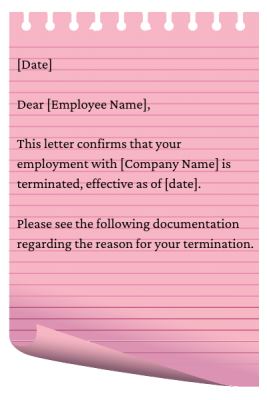What to include in an employee termination form
 The process of terminating an employee may look different for each company. However, you must handle employee turnover with an elevated level of professionalism and sensitivity. Having a standard employee termination form creates consistency in your organization’s process.
The process of terminating an employee may look different for each company. However, you must handle employee turnover with an elevated level of professionalism and sensitivity. Having a standard employee termination form creates consistency in your organization’s process.
There is no federal law requiring companies to issue a termination letter. However, many companies feel the termination process is just as important as the hiring process and want to maintain a professional reputation. As well, having a written notification of why the relationship between the employer and employee ended, is just good practice. Documenting these details also protects employers in the case of future termination-related litigation.
Providing a termination letter has become a universally acceptable, practical, and professional way to notify an employee that he or she has been fired. Below, we take some of the guesswork out of what a termination letter is, how to write one, and what should be included.
What is an employee termination form?
An employee termination form, also called a pink slip, letter of termination, contract termination letter, letter of separation, or notice of termination of employment, is a document sent to an employee, notifying them that they are being fired. It includes specific details regarding why the employee has been terminated and an outline of what to expect throughout the process.
When should you use an employee termination form?
An employee termination form should be used to notify an employee that he or she has been fired. This is true in the case of misconduct, or if the employee is laid-off. Usually, it’s not required, unless your state or local government has any specific regulations. However, you should still provide the form to protect from possible legal action as a result of the termination, and to provide relevant information about the next steps in the termination process.
What to include in your employee termination letter
You can always customize your employee termination form to include what you deem necessary. However, here are some common fields to include in an employee termination form.
Employee name
The very first item to include in your employee termination letter is the employee’s full legal name. If applicable, include the employee’s work ID number along with their position, title, and department.
The date of termination
First, notify the employee that he or she has been fired and what their effective last day of employment is. If the date is sometime in the future, it provides ample time for the employee to remove personal items from their office or workspace, turn in keys or work-related items, and tie up any last-minute tasks or duties. However, many companies terminate employees immediately. Regardless, make the official termination date clear.
Reason(s) for the employee’s termination
During this step provide the terminated employee with as many details as possible, including any supporting documentation regarding the reason for termination. If the employee is being fired for one or a multitude of reasons or infractions, list them all. This will help to avoid any misunderstandings or unnecessary confusion when he or she receives the termination letter.
Documented disciplinary action prior to termination
Most employees in the United States are at-will employees. This means they can be fired at any time for any reason. A documented or undocumented prior disciplinary action is not required to sever the employer and employee relationship. However, including prior punitive actions imposed on the employee to cure or deter unwanted behavior in the workplace, such as a written warning, will further strengthen the employee’s understanding of why they are being terminated.
Additionally, this is important in case an employee files a wrongful termination lawsuit in the future. You’ll want documentation to prove that neither discrimination nor retaliation were at play.
Employee benefits
Inform the terminated employee of any benefits that will be available to them and when those benefits will end. Include information about health insurance, retirement, stock options, etc.
Employee acknowledgment of termination
Include a section for the terminated employee to sign and acknowledge the termination. This does not necessarily mean they agree with the reason. However, an employee is not legally required to sign the termination letter. Neither is their acknowledgment a requirement for you to execute the employee’s termination.
Terminated employee’s forwarding address
More likely than not, you will need to communicate with the terminated employee after their final day. Confirm all contact information, including their address and best phone number.
Instructions for their last paycheck
This section should include the details about when they will receive their final paycheck. Most employees receive direct deposits. However, if your company provides paper checks, tell them when they can pick up their final paycheck and from whom.
 Severance pay
Severance pay
If an employee is terminated due to a layoff, notify them about the terms of their severance package. This should also include back pay owed, payment for unused vacation, holiday, sick, and leave days, as well as any additional compensation you provide.
Termination checklist
Each termination is unique, but some action items are common across all terminations. Having a checklist will assist you with that. Your company’s checklist may focus on the entire termination process from beginning to end. Or, your checklist may focus on items that require specific action like returning company property, deactivating the terminated employees’ security badge, and deleting or redirecting their email address or voice mail. You may choose to create one or many checklists to ensure a smooth termination process.
Human resources contact information
One of the last, if not final, parts of your employee termination form is providing human resources contact information. The HR representative or manager assigned to the terminated employee should sign off on the termination letter.
Having a company representative familiar with the terms of the termination will greatly reduce confusion if the employee has questions in the future. The HR representative can also provide additional information about existing health insurance, life insurance, 401K and investments, COBRA, etc.
Regardless of whether your company has one or thousands of employees, having an organized, comprehensive, and detailed employee termination letter or form will help to greatly increase clarity throughout the termination process.





